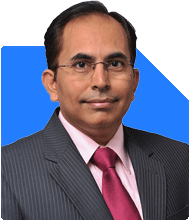Ramalingam Kalirajan |10881 Answers |Ask -Follow
Mutual Funds, Financial Planning Expert - Answered on Jun 06, 2024
He has an MBA in finance from the University of Madras and is a certified financial planner.
He is the director and chief financial planner at Holistic Investment, a Chennai-based firm that offers financial planning and wealth management advice.... more

I have 2 lakh and wanted to invest in lumpsum mutual fund for 10+ years. I am ready to take 100% risk. Please suggest me some funds
Congratulations on your decision to invest Rs 2 lakh in mutual funds for the long term! Your readiness to take 100% risk suggests you are looking for high-growth opportunities. Let's explore various mutual fund options that align with your risk appetite and investment horizon.
Understanding High-Risk Investments
High-risk investments are typically equity-based. They offer the potential for high returns but come with significant volatility. For a 10+ year horizon, equity mutual funds are ideal. Let's dive into different types of equity funds that can suit your profile.
Equity Mutual Funds
Equity mutual funds invest primarily in stocks. They are categorized based on the market capitalization of the companies they invest in, the sectors they focus on, and their investment strategies.
Large-Cap Funds
Large-cap funds invest in well-established companies with large market capitalizations. These companies have a track record of stability and consistent growth.
Benefits:
Stability: Less volatile compared to mid-cap and small-cap funds.
Reliable Growth: Offer steady returns over the long term.
Assessment:
Large-cap funds are suitable for investors seeking moderate risk with reliable growth. They are less risky than mid-cap and small-cap funds but offer lower potential returns.
Mid-Cap Funds
Mid-cap funds invest in medium-sized companies. These companies have the potential for higher growth compared to large-cap companies but are also more volatile.
Benefits:
Growth Potential: Higher potential for capital appreciation than large-cap funds.
Balanced Risk: Moderate risk, balancing stability and growth.
Assessment:
Mid-cap funds are ideal for investors willing to take on moderate risk for higher returns. They offer a good balance between stability and growth potential.
Small-Cap Funds
Small-cap funds invest in smaller companies with high growth potential. These funds are the most volatile but can offer the highest returns over the long term.
Benefits:
High Returns: Potential for significant capital appreciation.
Growth Opportunities: Invest in emerging companies with high growth prospects.
Assessment:
Small-cap funds are best suited for aggressive investors ready to embrace high volatility for substantial returns. They require patience and a long-term outlook.
Multi-Cap Funds
Multi-cap funds invest in companies across various market capitalizations. They provide diversification by investing in large-cap, mid-cap, and small-cap companies.
Benefits:
Diversification: Spread risk across different market capitalizations.
Flexibility: Fund managers can shift investments based on market conditions.
Assessment:
Multi-cap funds are ideal for investors seeking diversification and flexibility. They balance risk and reward by investing across the market spectrum.
Sectoral/Thematic Funds
Sectoral and thematic funds focus on specific sectors or investment themes. These funds can offer high returns if the chosen sector or theme performs well.
Benefits:
Focused Investment: Target high-growth sectors or themes.
High Returns: Potential for significant returns if the sector/theme performs well.
Assessment:
Sectoral/thematic funds are suitable for investors with strong convictions about specific sectors or themes. They carry higher risk due to concentrated exposure.
Active vs. Passive Funds
Active Funds:
Managed by Experts: Fund managers actively select stocks to outperform the market.
Higher Fees: Management fees are higher due to active management.
Passive Funds:
Track Index: Mimic the performance of a market index.
Lower Fees: Management fees are lower due to passive management.
Disadvantages of Index Funds:
Limited Growth: Passive funds can’t outperform the market.
Missed Opportunities: May miss out on high-growth stocks not in the index.
Disadvantages of Direct Funds
Higher Effort Required:
Self-Management: Investors need to manage and monitor investments themselves.
Less Guidance:
No Professional Advice: Lack of professional advice can lead to poor investment choices.
Benefits of Regular Funds:
Expert Management: Professional fund managers make informed decisions.
Convenience: Easier to manage with guidance from a certified financial planner (CFP).
Recommended Investment Approach
Given your high-risk appetite and long-term horizon, an aggressive investment approach is suitable. Here's a detailed plan:
Step 1: Allocate Funds Across Different Categories
Diversification: Spread your investment across different types of equity funds to balance risk and return.
Example Allocation:
Large-Cap Funds: 30% for stability and reliable growth.
Mid-Cap Funds: 30% for balanced risk and higher returns.
Small-Cap Funds: 20% for high growth potential.
Multi-Cap Funds: 20% for diversification and flexibility.
Step 2: Research and Select Funds
Performance Analysis: Choose funds with a strong track record of performance over at least five years.
Consistency: Look for consistency in returns and management expertise.
Fund Manager: Evaluate the experience and strategy of the fund manager.
Step 3: Monitor and Review Regularly
Regular Monitoring: Track the performance of your investments periodically.
Rebalance Portfolio: Adjust your portfolio based on performance and changing market conditions.
Stay Informed: Keep abreast of market trends and economic changes.
The Importance of Long-Term Investment
Compounding Returns: Long-term investments benefit from compounding, leading to significant growth.
Market Cycles: Staying invested through market cycles helps in averaging returns.
Patience Pays: Long-term investments mitigate short-term volatility and provide higher returns.
Tax Implications
Equity Funds: Long-term capital gains (LTCG) on equity funds are taxed at 10% if gains exceed Rs 1 lakh in a financial year.
Tax Planning: Consider tax-saving mutual funds (ELSS) for additional benefits.
Conclusion
Investing Rs 2 lakh in lumpsum mutual funds for a 10+ year horizon with a high-risk appetite is a prudent decision. Diversify across large-cap, mid-cap, small-cap, and multi-cap funds to balance risk and maximize returns. Regularly monitor your portfolio and stay informed about market trends.
Consulting a Certified Financial Planner (CFP) can provide personalized guidance and ensure your investments align with your financial goals. With patience and disciplined investing, you can achieve significant growth over the long term.
Best Regards,
K. Ramalingam, MBA, CFP
Chief Financial Planner,
www.holisticinvestment.in
You may like to see similar questions and answers below
Janak Patel |71 Answers |Ask -Follow
MF, PF Expert - Answered on Oct 09, 2024
Milind Vadjikar | Answer |Ask -Follow
Insurance, Stocks, MF, PF Expert - Answered on Nov 26, 2024
Ramalingam Kalirajan |10881 Answers |Ask -Follow
Mutual Funds, Financial Planning Expert - Answered on Dec 09, 2024
Ramalingam Kalirajan |10881 Answers |Ask -Follow
Mutual Funds, Financial Planning Expert - Answered on Aug 04, 2025
Dr Dipankar Dutta |1841 Answers |Ask -Follow
Tech Careers and Skill Development Expert - Answered on Dec 14, 2025
Nayagam P P |10854 Answers |Ask -Follow
Career Counsellor - Answered on Dec 14, 2025
Radheshyam Zanwar |6744 Answers |Ask -Follow
MHT-CET, IIT-JEE, NEET-UG Expert - Answered on Dec 14, 2025
Radheshyam Zanwar |6744 Answers |Ask -Follow
MHT-CET, IIT-JEE, NEET-UG Expert - Answered on Dec 14, 2025
Dr Dipankar Dutta |1841 Answers |Ask -Follow
Tech Careers and Skill Development Expert - Answered on Dec 14, 2025
Dr Dipankar Dutta |1841 Answers |Ask -Follow
Tech Careers and Skill Development Expert - Answered on Dec 13, 2025
Dr Dipankar Dutta |1841 Answers |Ask -Follow
Tech Careers and Skill Development Expert - Answered on Dec 13, 2025
Mayank Chandel |2575 Answers |Ask -Follow
IIT-JEE, NEET-UG, SAT, CLAT, CA, CS Exam Expert - Answered on Dec 13, 2025
Radheshyam Zanwar |6744 Answers |Ask -Follow
MHT-CET, IIT-JEE, NEET-UG Expert - Answered on Dec 13, 2025
Mayank Chandel |2575 Answers |Ask -Follow
IIT-JEE, NEET-UG, SAT, CLAT, CA, CS Exam Expert - Answered on Dec 13, 2025
























